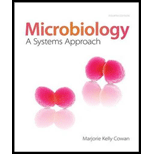
Microbiology: A Systems Approach
4th Edition
ISBN: 9780073402437
Author: Marjorie Kelly Cowan Professor
Publisher: McGraw-Hill Education
expand_more
expand_more
format_list_bulleted
Question
Chapter 20.3, Problem 13AYP
Summary Introduction
To discuss:
The epidemiology of HIV infection in the developed and developing world.
Concept introduction:
HIV belongs to the retroviruses family, all of which contains the RNA genome. The virus attaches and penetrates T cells of the human that play an essential role in the immunity of a person. Infected cells express the viral genes and produce new viruses which in turn infect other T cells leading to a decrease in the population of T cells. Eventually, loss of T cells results in a decline in the immune system of the body for other diseases as well.
Expert Solution & Answer
Want to see the full answer?
Check out a sample textbook solution
Students have asked these similar questions
Give only the mode of inheritance consistent with all three pedigrees and only two reasons that support this, nothing more, (it shouldn't take too long)
O
Describe the principle of homeostasis.
Chapter 20 Solutions
Microbiology: A Systems Approach
Ch. 20.1 - Describe the important anatomical features of the...Ch. 20.1 - List the natural defenses present in the...Ch. 20.2 - Prob. 3AYPCh. 20.3 - Prob. 2CFCh. 20.3 - Prob. 4AYPCh. 20.3 - Prob. 5AYPCh. 20.3 - Prob. 6AYPCh. 20.3 - Prob. 7AYPCh. 20.3 - Prob. 8AYPCh. 20.3 - Prob. 9AYP
Ch. 20.3 - Prob. 10AYPCh. 20.3 - Prob. 11AYPCh. 20.3 - Prob. 12AYPCh. 20.3 - Prob. 13AYPCh. 20 - Prob. 1CFCh. 20 - Prob. 1MCQCh. 20 - Prob. 2MCQCh. 20 - Prob. 3MCQCh. 20 - Rabbit fever is caused by a. Yersinia pestis. b....Ch. 20 - Prob. 5MCQCh. 20 - Prob. 6MCQCh. 20 - Prob. 7MCQCh. 20 - Prob. 8MCQCh. 20 - Prob. 9MCQCh. 20 - Prob. 10MCQCh. 20 - Brucellosis can be transmitted to humans by...Ch. 20 - Prob. 12TFCh. 20 - Prob. 13TFCh. 20 - Prob. 14TFCh. 20 - Prob. 15TFCh. 20 - Prob. 1CTQCh. 20 - Explain why cases of dengue fever have been...Ch. 20 - Prob. 3CTQCh. 20 - Prob. 4CTQCh. 20 - Prob. 5CTQCh. 20 - Prob. 6CTQCh. 20 - Prob. 7CTQCh. 20 - Prob. 8CTQCh. 20 - Prob. 9CTQCh. 20 - Prob. 10CTQCh. 20 - Prob. 1CCCh. 20 - Prob. 2CCCh. 20 - Prob. 3CCCh. 20 - Prob. 4CCCh. 20 - Prob. 1VCCh. 20 - Prob. 1CM
Knowledge Booster
Similar questions
- Explain how the hormones of the glands listed below travel around the body to target organs and tissues : Pituitary gland Hypothalamus Thyroid Parathyroid Adrenal Pineal Pancreas(islets of langerhans) Gonads (testes and ovaries) Placentaarrow_forwardWhat are the functions of the hormones produced in the glands listed below: Pituitary gland Hypothalamus Thyroid Parathyroid Adrenal Pineal Pancreas(islets of langerhans) Gonads (testes and ovaries) Placentaarrow_forwardDescribe the hormones produced in the glands listed below: Pituitary gland Hypothalamus Thyroid Parathyroid Adrenal Pineal Pancreas(islets of langerhans) Gonads (testes and ovaries) Placentaarrow_forward
- Please help me calculate drug dosage from the following information: Patient weight: 35 pounds, so 15.9 kilograms (got this by dividing 35 pounds by 2.2 kilograms) Drug dose: 0.05mg/kg Drug concentration: 2mg/mLarrow_forwardA 25-year-old woman presents to the emergency department with a 2-day history of fever, chills, severe headache, and confusion. She recently returned from a trip to sub-Saharan Africa, where she did not take malaria prophylaxis. On examination, she is febrile (39.8°C/103.6°F) and hypotensive. Laboratory studies reveal hemoglobin of 8.0 g/dL, platelet count of 50,000/μL, and evidence of hemoglobinuria. A peripheral blood smear shows ring forms and banana-shaped gametocytes. Which of the following Plasmodium species is most likely responsible for her severe symptoms? A. Plasmodium vivax B. Plasmodium ovale C. Plasmodium malariae D. Plasmodium falciparumarrow_forwardStandard Concentration (caffeine) mg/L Absorbance Reading 10 0.322 20 0.697 40 1.535 60 2.520 80 3.100arrow_forward
- please draw in the answers, thank youarrow_forwarda. On this first grid, assume that the DNA and RNA templates are read left to right. DNA DNA mRNA codon tRNA anticodon polypeptide _strand strand C с A T G A U G C A TRP b. Now do this AGAIN assuming that the DNA and RNA templates are read right to left. DNA DNA strand strand C mRNA codon tRNA anticodon polypeptide 0 A T G A U G с A TRParrow_forwardplease answer all question below with the following answer choice, thank you!arrow_forward
arrow_back_ios
SEE MORE QUESTIONS
arrow_forward_ios
Recommended textbooks for you
 Comprehensive Medical Assisting: Administrative a...NursingISBN:9781305964792Author:Wilburta Q. Lindh, Carol D. Tamparo, Barbara M. Dahl, Julie Morris, Cindy CorreaPublisher:Cengage LearningHealth Safety And Nutrition F/Young ChildHealth & NutritionISBN:9781305144767Author:MAROTZPublisher:Cengage
Comprehensive Medical Assisting: Administrative a...NursingISBN:9781305964792Author:Wilburta Q. Lindh, Carol D. Tamparo, Barbara M. Dahl, Julie Morris, Cindy CorreaPublisher:Cengage LearningHealth Safety And Nutrition F/Young ChildHealth & NutritionISBN:9781305144767Author:MAROTZPublisher:Cengage- Lifetime Physical Fitness & WellnessHealth & NutritionISBN:9781337677509Author:HOEGERPublisher:Cengage


Comprehensive Medical Assisting: Administrative a...
Nursing
ISBN:9781305964792
Author:Wilburta Q. Lindh, Carol D. Tamparo, Barbara M. Dahl, Julie Morris, Cindy Correa
Publisher:Cengage Learning

Health Safety And Nutrition F/Young Child
Health & Nutrition
ISBN:9781305144767
Author:MAROTZ
Publisher:Cengage

Lifetime Physical Fitness & Wellness
Health & Nutrition
ISBN:9781337677509
Author:HOEGER
Publisher:Cengage

